The importance of beauty on Earth Day
Depriving people of beauty is one reason our world is sadder and sicker than it should be
I grew up in an ugly world.
But most of the houses and roads around us—in the Minnesota and Silicon Valley suburbs—were the same, ugly in ways that much of the US is ugly. (On YouTube: The US Is Ugly. THIS is Why.)
When I was small, there was a single apple tree just over the fence from our small yard. When it bloomed and its fragrance filled the air, I discovered beauty.
I worry about children growing up in some of the streets I see as I take the train into Manhattan. The contrast between poorer and wealthier areas is striking on a beautiful spring morning. The northern part of the island is gray and brown, with few street trees. On the upper east side, however, Park Avenue is lined with tulips and every planter box and tree surround is full of flowers. The scent of hyancinths follows us.
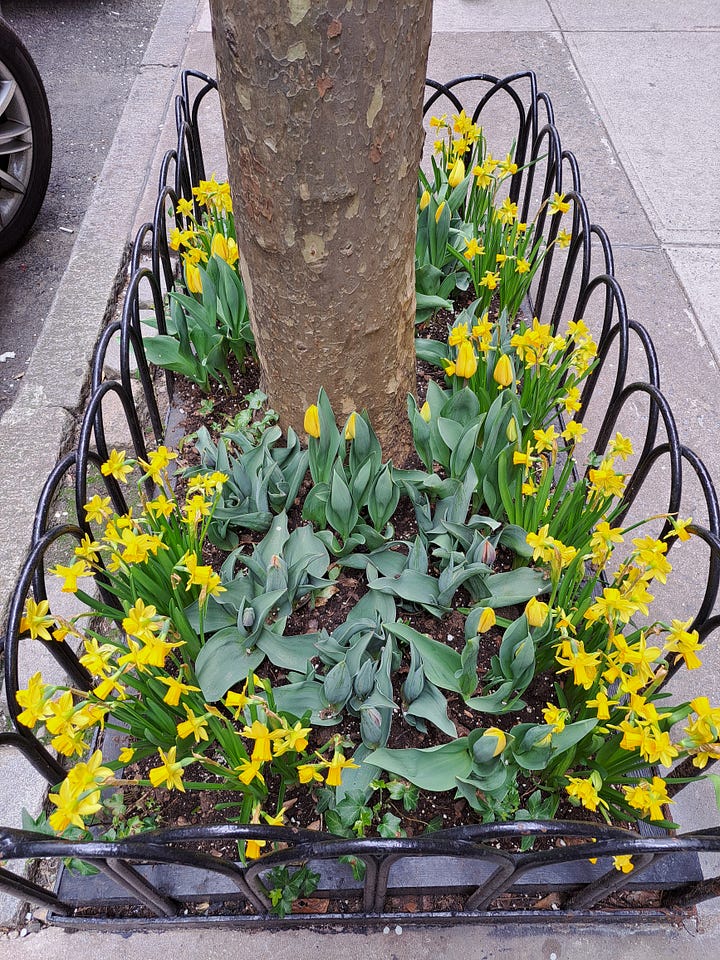
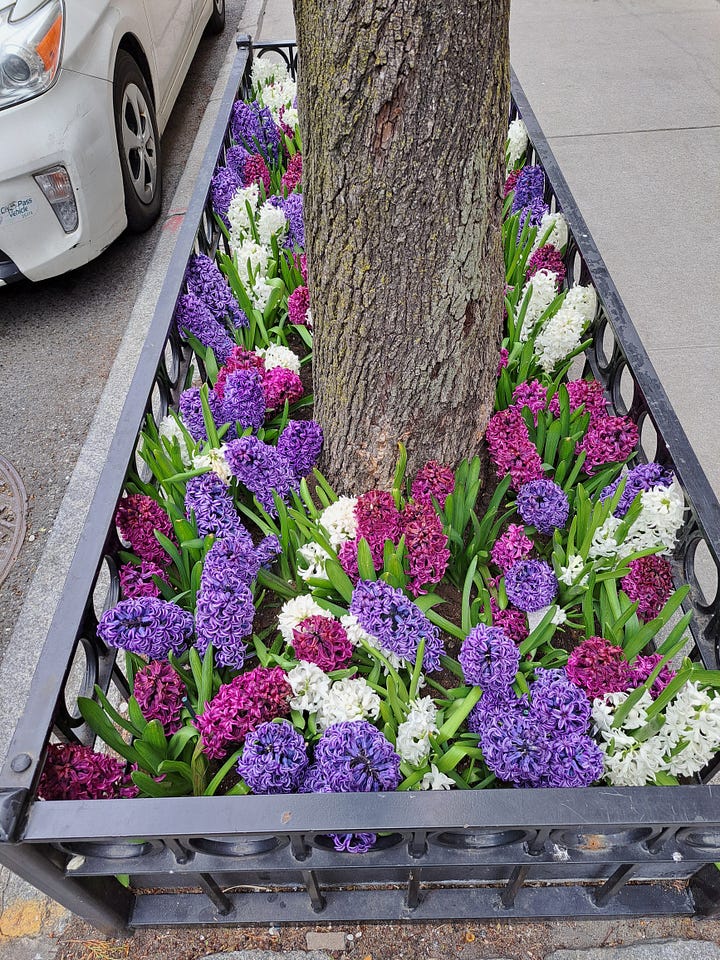
Depriving people of beauty is one reason our world is sadder and sicker than it needs to be.
The Park Avenue flowers are expensive to maintain, but I’ve seen mountain villages in Mexico where flowers and vines bloomed in a line of tin cans. Flowers, and other beautiful things, shouldn’t just be for the wealthy.
Like flowering trees, many bulbs rebloom year after year, and some spread, too, like the blue scilla that is a blue lake at one side of my garden. As a child I was as ignorant of these treasures as the young heroine of The Secret Garden:
In the course of her digging with her pointed stick Mistress Mary had found herself digging up a sort of white root rather like an onion. She had put it back in its place and patted the earth carefully down on it and just now she wondered if Martha could tell her what it was.
"Martha," she said, "what are those white roots that look like onions?"
"They're bulbs," answered Martha. "Lots o' spring flowers grow from 'em. Th' very little ones are snowdrops an' crocuses an' th' big ones are narcissusis an' jonquils an' daffydowndillys. Th' biggest of all is lilies an' purple flags. Eh! they are nice. Dickon's got a whole lot of 'em planted in our bit o' garden."
"Do bulbs live a long time? Would they live years and years if no one helped them?" inquired Mary anxiously.
"They're things as helps themselves," said Martha. "That's why poor folk can afford to have 'em. If you don't trouble 'em, most of 'em'll [Pg 104]work away underground for a lifetime an' spread out an' have little 'uns. There's a place in th' park woods here where there's snowdrops by thousands. They're the prettiest sight in Yorkshire when th' spring comes. No one knows when they was first planted."
Many public parks are beautiful and joyful, while some are so bare that it’s no surprise to see them empty. I think of a park in Springfield, Mass. Even at this time of year it is bare of flowers and empty of people. The grass is mowed, but there’s nothing to draw anyone to it, not so much as a bench.
How did it happen?
I’ve been reading a lot of economics and architecture of late, as I work on new chapters in The Great Good Place II. To my surprise, these books have more about social life and values and beauty than some tomes by social scientists. Notably, in The Joyless Economy, we read about the importance of cut flowers—to some people, in some places.
Not in America, however. Americans, writes the economist author, spent much less on fresh flowers than people in the European countries he surveyed.
I remember the tiny bunches of dewy snowdrops and violets in the market in Krakow, and the freesias I could pick up for a few pounds from a street stall in London. In some countries, it’s unheard of to turn up for a visit without flowers or some other small gift. Here in the US, however, lavish display of fresh flowers is a sign of wealth—domestic or corporate. Instead, we have long-lasting, scentless varieties flown in from Colombia and bouqets for weddings and sickbeds, not for the family dining table.
Americans’ tolerance of ugliness goes back, some say, to the Puritans. Ornamentation was for Catholics. Plainness signaled virtue.
Somewhere along the way plainness turned into ugliness. Simple, stark beauty of Shaker and Amish design became the harsh utiliarianism that too many of us live with today.
Disagree? There’s more below but I’m happy to take comments and criticism even now!
It’s not just Puritans and Americans who disdain the beautiful. Environmentalists and reformers can be just as bad. I once decided against moving to an intentional community because I couldn’t bear the idea of eating at a purple plywood table or sitting on brown vinyl cushions. I was too frivolous, too concerned about appearances, for that group of do-gooders.
A recent article in the Financial Times, “It’s time for politicians and bosses to prioritise beauty,” focuses on wind farms and light pollution but also mentions arts and design edition. Stuart Kirk writes that “beauty is a good we generate in our own heads. Thus it is unlimited in supply and depletes no external resources in its making.” He calls for “more painters and design schools please, and fewer Olympic canoers and spreadsheets. And as voters and shareholders, we must never be embarrassed to say: ‘That hilltop of solar panels is ugly. Remove them now.’” Read the whole thing.
Are solar panels and wind turbines ugly? Or is the problem that they replace things are beautiful?
Beauty can connect us
It is cherry-blossom season and the Japanese have a whole set of words for different aspections of this cherished display. I especially love the way the blowing and falling petals are recognized as beautiful, not only the blossom at its peak.
Kintsugi is an art related to the Japanese concept wabi-sabi: seeking beauty in that which impermanent, like cherry blossoms, and imperfect, like this Chinese bowl, which I broke not long after buying it in Camden Market in London many years ago. Kintsugi a kind of repair and reuse that resonates with me on this Earth Day.
World historian William H. McNeill wrote this in Foreign Affairs:
Seeing contemporary foreign affairs as a continuation of longstanding processes of cultural encounter will surely teach us not to expect the various peoples of the earth to wish to be like us any more than we wish to be like them. . . . The fact that nearly everyone prefers wealth and power to poverty and helplessness does not therefore assure any uniformity in the way different peoples will choose to pursue the common goal. Nor are material goods everything. Beauty and holiness are also widely disseminated ideals, and the desire for membership in a supportive community of comrades is an even more universal and, often, passionate desire.
Beauty plays a part in mental health. This passage comes from We've Had a Hundred Years of Psychotherapy: And the World's Getting Worse by James Hillman and Michael Ventura:
The prejudices against beauty expose our culture’s actual preference for ugliness disguised as the useful, the practical, the moral, the new, and the quick. The reason for this repression of beauty, in therapy too—for beauty doesn’t come into therapy any more than it comes into the mall or the workplace—is nothing less than the taproot of all American culture: puritanism. You see, taste, as the word itself says, awakens the senses and releases fantasies. Taste remembers beauty; it enjoys pleasure; it tends to refine itself toward more interesting joys. Puritanism would much rather focus on hard realities and moral choices that you have to suffer through and work for. But for me, the greatest moral choice we can make today, if we are truly concerned with the oppressed and stressed lives of our clients’ souls, is to sharpen their sense of beauty.
What we can do now
No one may remember who did the planting, but we can create beauty anywhere. We can also bring beauty to life by noticing it and talking about it—complimenting a shop owner or neighbor who has made an effort to create something lovely for those walking by.
And we can remember that all of us need food for our souls as well as our bodies. These lines are attributed to a range of people and poets and the ancient Persians:
If thou of fortune be bereft, and in thy store there be but left two loaves, sell one, and with the dole, buy hyacinths to feed thy soul.
I’ve seen it quoted with “a lily” instead of hyacinths, but I prefer the reading with hyacinths because white hyancinths were Rachel Carson’s favorite flower—thus, in my mind, the perfect flower for this Earth Day.
Links
Jane Austen’s Sense and Sensibility introduces the Romantic ideal of beauty. This passage always makes me laugh, as Elinor’s old-fashioned lover argues with the romantic Marianne:
“I do not like crooked, twisted, blasted trees. I admire them much more if they are tall, straight, and flourishing. I do not like ruined, tattered cottages. I am not fond of nettles or thistles, or heath blossoms. I have more pleasure in a snug farm-house than a watch-tower—and a troop of tidy, happy villages please me better than the finest banditti in the world.”
Marianne looked with amazement at Edward, with compassion at her sister. Elinor only laughed.
Perhaps we shouldn’t be reading Austen anyway. The philosopher who wrote this 2000 piece, “An Essay on Beauty and Judgment,” comments, “I will run the risk of asserting that where the reading of novels prevails as a habit, it occasions in time the entire destruction of the powers of the mind.” That sounds like something one of Jane Austen’s characters would say!
Art and beauty continue to be subject to debate. This recent post is about a statue of Martin Luther King Jr. “It was University of Chicago art historian Barbara Maria Stafford who looked about her at the state of what passed for ‘art’ and asked: ‘Why, in order to be taken seriously, do things have to be ugly.’”
I sometimes think ugliness is a guiding principle for departments of transportation. Architect John Massengale, whom I’ll interview soon about the new edition of his Street Design: The Secret to Great Cities and Towns, writes about beauty often. His commentary on the street “improvements” in Great Barrington came to mind today as I saw the patchy spring display of the trees he wrote about in this article.
Then there’s an account I wrote some years ago about a strange experience here in the Berkshires: https://www.berkshirepublishing.com/blog/our-hearts-garden/,. You can read the whole thing at the link, but here’s how I described a curious little garden in the hills: Everything that people try to conjure up with springtime celebrations, with Easter eggs and Easter bonnets, candy rabbits and pots of pink hyacinths – hope and laughter, boundless joy, the exuberance of life renewed – was there in those flowers, dancing in the sunshine above the warm dark stone.


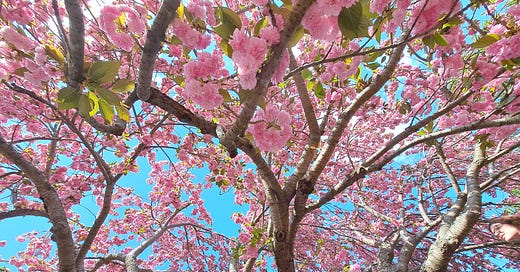



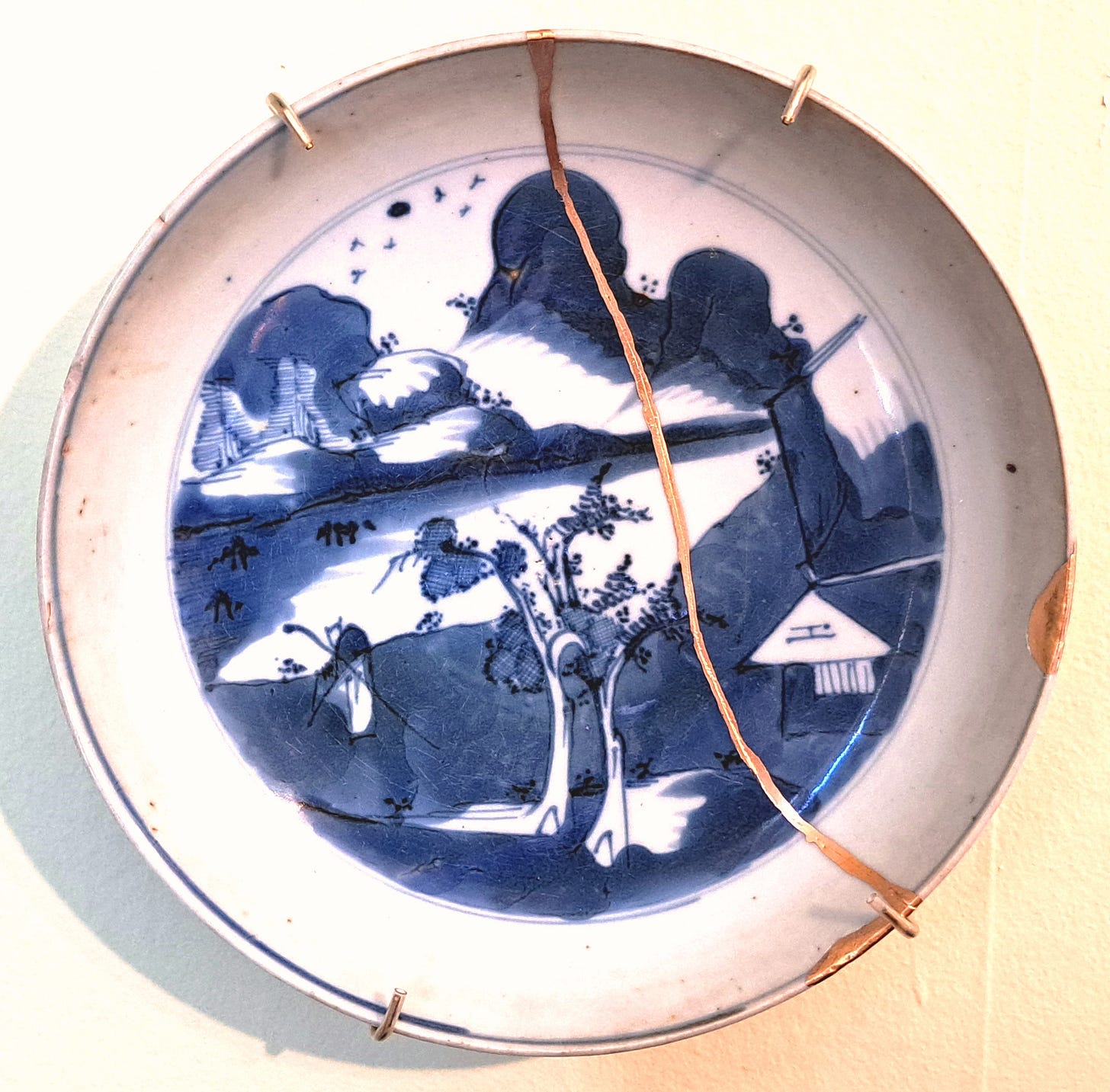

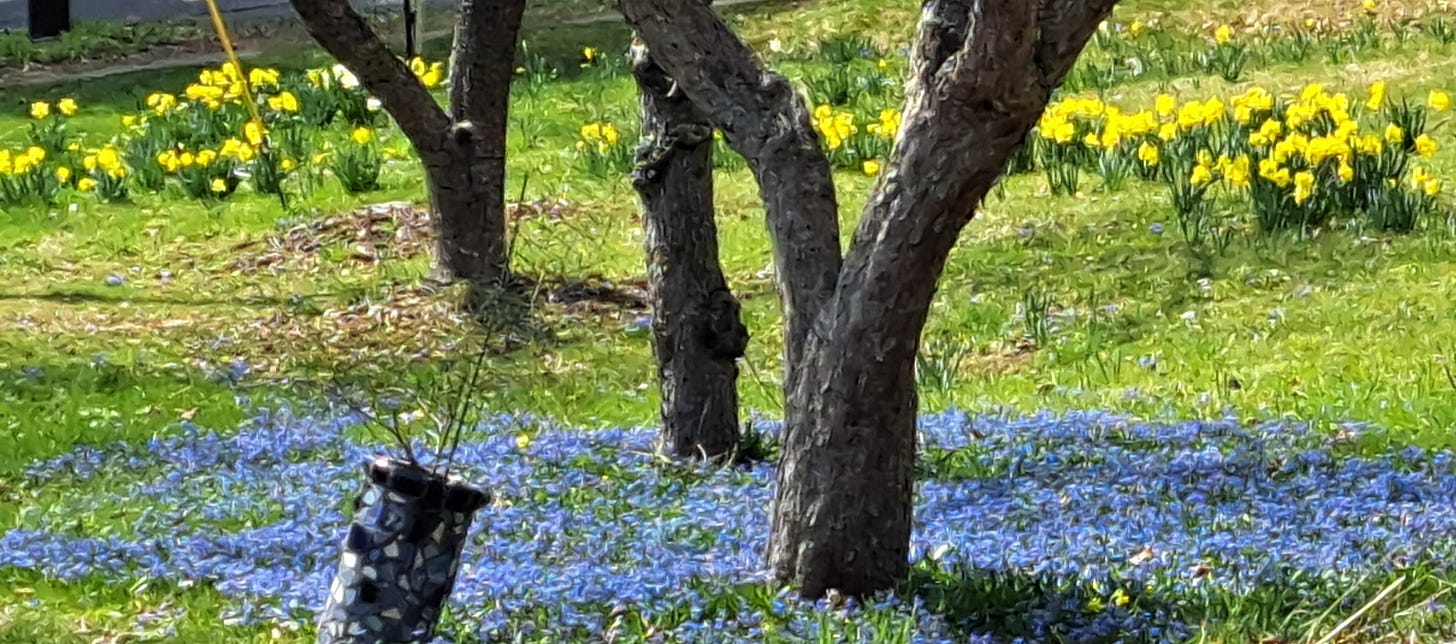
I greatly enjoyed your observations on beauty. However, two comments dropped me like an anchor into darkness.
1) And as voters and shareholders, we must never be embarrassed to say: ‘That hilltop of solar panels is ugly. Remove them now.’
In the 19th century, the telephone poles were destroyed because they interfered with the spiritual and aesthetic powers of feng shui. Henry Ford allegedly replied to a critique of the automobile, which replaced horses by asking: "Do you want to spend your life picking up horse manure?" (The quotation is not true to the original, but at 86 years of age, I plead a pardon for bungling the original." As for me, the solar panels in the fields are a relief from silos, and power lines. Their ty affects our soul and sense of security. I like the economic effect of solar power, which can often be offset with refunds, and relies on less carbon output than the production of electricity and than the carbon-producing fertilizers in the fields. I feel serene knowing that the users are getting a better deal. And windmills are beautiful too in the same way.
2) The comment about reading (originally from a Greek philosopher whose name I have forgotten),: If you depend on reading and writing, you lose your memory, with the loss of being able to feel the instant sensations of your existence and the meaning of your senses.
Other than that, I greatly enjoy your essays\.
Your link to "Olivia's Overlook" got a 404 error, but I remembered "Our Heart's Garden" the very fine piece of writing you did in 2018, with the later links to the sad end to that story, anda search quickly found it.
- Jim Miller